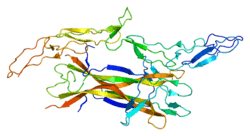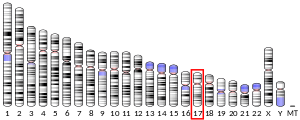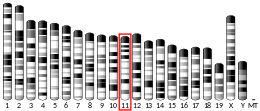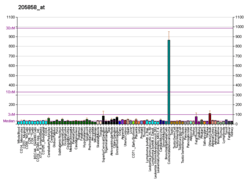Low-affinity nerve growth factor receptor
The low-affinity nerve growth factor receptor (nerve growth factor receptor (TNFR superfamily, member 16), also called the LNGFR or p75 neurotrophin receptor) is one of the two receptor types for the neurotrophins, a family of protein growth factors that stimulate neuronal cells to survive and differentiate. LNGFR is a member of the tumor necrosis factor receptor (TNF receptor)superfamily – indeed, LNGFR was the first member of this large family of receptors to be characterized.[5][6]
Neurotrophins
Neurotrophins include four proteins, all of which bind to the LNGFR: nerve growth factor (NGF), brain derived neurotrophic factor (BDNF), neurotrophin-3 (NT-3), and neurotrophin-4 (NT-4).
Nerve growth factor, the prototypical growth factor, is a protein secreted by a neuron's target. NGF is critical for the survival and maintenance of sympathetic and sensory neurons. NGF is released from the target cells, binds to and activates its high-affinity receptor tropomyosin receptor kinase A (TrkA), and is internalized into the responsive neuron. The NGF/TrkA complex is subsequently trafficked back to the cell body. This movement of NGF from axon tip to soma is thought to be involved in the long-distance signaling of neurons.
The activation of TrkA by NGF is critical in inducing the survival and differentiation caused by this growth factor.
However, NGF binds at least two receptors on the surface of cells that are capable of responding to this growth factor, TrkA (pronounced "Track A") and the LNGFR.
Trk family of receptor tyrosine kinases
TrkA is a receptor tyrosine kinase (meaning it mediates its actions by causing the addition of phosphate molecules on certain tyrosines in the cell, activating cellular signaling). There are other related Trk receptors, TrkB and TrkC. Also, there are other neurotrophic factors structurally related to NGF: BDNF (for Brain-Derived Neurotrophic Factor), NT-3 (for Neurotrophin-3) and NT-4 (for Neurotrophin-4). While TrkA mediates the effects of NGF, TrkB binds and is activated by BDNF, NT-4, and NT-3, and TrkC binds and is activated only by NT-3.
Function
Neurotrophins activating LNGFR may signal a cell to die via apoptosis, but this effect is counteracted by anti-apoptotic signaling by TrkA, TrkB, or TrkC signaling in cells that also express those receptors. LNGFR functions in a complex with Nogo receptor (NgR, Reticulon 4 receptor) to mediate RhoA-dependent inhibition of growth of regenerating axons exposed to inhibitory proteins of CNS myelin, such as Nogo, MAG or OMgP. LNGFR also activates a caspase-dependent signaling pathway that promotes developmental axon pruning, and axon degeneration in neurodegenerative disease.
Recent research has suggested a number of roles for the LNGFR, including in development of the eyes and sensory neurons,[7][8] and in repair of muscle and nerve damage in adults.[9][10][11]
Two distinct subpopulations of Olfactory ensheathing glia (being researched for nerve repair) have been identified[12] with high or low cell surface expression of low-affinity nerve growth factor receptor (p75).
Role in cancer stem cells
LNGFR has been implicated as a marker for cancer stem cells in melanoma and other cancers. Melanoma cells transplanted into an immunodeficient mouse model were shown to require expression of CD271 in order to grow a melanoma.[13] Gene knockdown of CD271 has also been shown to abolish neural crest stem cell properties of melanoma cells and decrease genomic stability leading to a reduced migration, tumorigenicity, proliferation and induction of apoptosis.[14][15][16] Furthermore, increased levels of CD271 were observed in brain metastatic melanoma cells whereas resistance to the BRAF inhibitor vemurafenib supposedly selects for highly malignant brain and lung-metastasizing melanoma cells.[17][18][19][20]
Interactions
Low-affinity nerve growth factor receptor has been shown to interact with:
References
- GRCh38: Ensembl release 89: ENSG00000064300 - Ensembl, May 2017
- GRCm38: Ensembl release 89: ENSMUSG00000000120 - Ensembl, May 2017
- "Human PubMed Reference:". National Center for Biotechnology Information, U.S. National Library of Medicine.
- "Mouse PubMed Reference:". National Center for Biotechnology Information, U.S. National Library of Medicine.
- Johnson D, Lanahan A, Buck CR, Sehgal A, Morgan C, Mercer E, Bothwell M, Chao M (November 1986). "Expression and structure of the human NGF receptor". Cell. 47 (4): 545–54. doi:10.1016/0092-8674(86)90619-7. PMID 3022937.
- Radeke MJ, Misko TP, Hsu C, Herzenberg LA, Shooter EM (1987). "Gene transfer and molecular cloning of the rat nerve growth factor receptor". Nature. 325 (6105): 593–7. doi:10.1038/325593a0. PMID 3027580.
- Nicol GD (October 2008). "Nerve growth factor, sphingomyelins, and sensitization in sensory neurons". Sheng Li Xue Bao. 60 (5): 603–4. PMID 18958367.
- Di Girolamo N, Sarris M, Chui J, Cheema H, Coroneo MT, Wakefield D (December 2008). "Localization of the low-affinity nerve growth factor receptor p75 in human limbal epithelial cells". Journal of Cellular and Molecular Medicine. 12 (6B): 2799–811. doi:10.1111/j.1582-4934.2008.00290.x. PMC 3828893. PMID 19210757.
- Chen LW, Yung KK, Chan YS, Shum DK, Bolam JP (December 2008). "The proNGF-p75NTR-sortilin signalling complex as new target for the therapeutic treatment of Parkinson's disease". CNS & Neurological Disorders Drug Targets. 7 (6): 512–23. doi:10.2174/187152708787122923. PMID 19128208.
- Kocsis JD, Lankford KL, Sasaki M, Radtke C (June 2009). "Unique in vivo properties of olfactory ensheathing cells that may contribute to neural repair and protection following spinal cord injury". Neuroscience Letters. 456 (3): 137–42. doi:10.1016/j.neulet.2008.08.093. PMC 2713444. PMID 19429149.
- Deponti D, Buono R, Catanzaro G, De Palma C, Longhi R, Meneveri R, Bresolin N, Bassi MT, Cossu G, Clementi E, Brunelli S (August 2009). "The low-affinity receptor for neurotrophins p75NTR plays a key role for satellite cell function in muscle repair acting via RhoA". Molecular Biology of the Cell. 20 (16): 3620–7. doi:10.1091/mbc.E09-01-0012. PMC 2777922. PMID 19553472.
- Honoré A, Le Corre S, Derambure C, Normand R, Duclos C, Boyer O, Marie JP, Guérout N (March 2012). "Isolation, characterization, and genetic profiling of subpopulations of olfactory ensheathing cells from the olfactory bulb". Glia. 60 (3): 404–13. doi:10.1002/glia.22274. PMID 22161947.
- Boiko AD, Razorenova OV, van de Rijn M, Swetter SM, Johnson DL, Ly DP, Butler PD, Yang GP, Joshua B, Kaplan MJ, Longaker MT, Weissman IL (July 2010). "Human melanoma-initiating cells express neural crest nerve growth factor receptor CD271". Nature. 466 (7302): 133–7. doi:10.1038/nature09161. PMC 2898751. PMID 20596026.
- Redmer T, Welte Y, Behrens D, Fichtner I, Przybilla D, Wruck W, Yaspo ML, Lehrach H, Schäfer R, Regenbrecht CR (2014). "The nerve growth factor receptor CD271 is crucial to maintain tumorigenicity and stem-like properties of melanoma cells". PLOS One. 9 (5): e92596. doi:10.1371/journal.pone.0092596. PMC 4010406. PMID 24799129.
- Redmer T, Walz I, Klinger B, Khouja S, Welte Y, Schäfer R, Regenbrecht C (January 2017). "The role of the cancer stem cell marker CD271 in DNA damage response and drug resistance of melanoma cells". Oncogenesis. 6 (1): e291. doi:10.1038/oncsis.2016.88. PMC 5294251. PMID 28112719.
- Radke J, Roßner F, Redmer T (August 2017). "CD271 determines migratory properties of melanoma cells". Scientific Reports. 7 (1): 9834. doi:10.1038/s41598-017-10129-z. PMC 5574914. PMID 28852061.
- Guo R, Fierro-Fine A, Goddard L, Russell M, Chen J, Liu CZ, Fung KM, Hassell LA (2014). "Increased expression of melanoma stem cell marker CD271 in metastatic melanoma to the brain". International Journal of Clinical and Experimental Pathology. 7 (12): 8947–51. PMC 4313973. PMID 25674270.
- Radke J, Roßner F, Redmer T (August 2017). "CD271 determines migratory properties of melanoma cells". Scientific Reports. 7 (1): 9834. doi:10.1038/s41598-017-10129-z. PMC 5574914. PMID 28852061.
- Zubrilov I, Sagi-Assif O, Izraely S, Meshel T, Ben-Menahem S, Ginat R, Pasmanik-Chor M, Nahmias C, Couraud PO, Hoon DS, Witz IP (May 2015). "Vemurafenib resistance selects for highly malignant brain and lung-metastasizing melanoma cells". Cancer Letters. 361 (1): 86–96. doi:10.1016/j.canlet.2015.02.041. PMID 25725450.
- Redmer T (July 2018). "Deciphering mechanisms of brain metastasis in melanoma - the gist of the matter". Molecular Cancer. 17 (1): 106. doi:10.1186/s12943-018-0854-5. PMC 6064184. PMID 30053879.
- Shonukan O, Bagayogo I, McCrea P, Chao M, Hempstead B (June 2003). "Neurotrophin-induced melanoma cell migration is mediated through the actin-bundling protein fascin". Oncogene. 22 (23): 3616–23. doi:10.1038/sj.onc.1206561. PMID 12789270.
- Tcherpakov M, Bronfman FC, Conticello SG, Vaskovsky A, Levy Z, Niinobe M, Yoshikawa K, Arenas E, Fainzilber M (December 2002). "The p75 neurotrophin receptor interacts with multiple MAGE proteins". The Journal of Biological Chemistry. 277 (51): 49101–4. doi:10.1074/jbc.C200533200. PMID 12414813.
- Kuwako K, Taniura H, Yoshikawa K (January 2004). "Necdin-related MAGE proteins differentially interact with the E2F1 transcription factor and the p75 neurotrophin receptor". The Journal of Biological Chemistry. 279 (3): 1703–12. doi:10.1074/jbc.M308454200. PMID 14593116.
- Bronfman FC, Tcherpakov M, Jovin TM, Fainzilber M (April 2003). "Ligand-induced internalization of the p75 neurotrophin receptor: a slow route to the signaling endosome". The Journal of Neuroscience. 23 (8): 3209–20. doi:10.1523/JNEUROSCI.23-08-03209.2003. PMID 12716928.
- Mukai J, Hachiya T, Shoji-Hoshino S, Kimura MT, Nadano D, Suvanto P, Hanaoka T, Li Y, Irie S, Greene LA, Sato TA (June 2000). "NADE, a p75NTR-associated cell death executor, is involved in signal transduction mediated by the common neurotrophin receptor p75NTR". The Journal of Biological Chemistry. 275 (23): 17566–70. doi:10.1074/jbc.C000140200. PMID 10764727.
- Nykjaer A, Lee R, Teng KK, Jansen P, Madsen P, Nielsen MS, Jacobsen C, Kliemannel M, Schwarz E, Willnow TE, Hempstead BL, Petersen CM (February 2004). "Sortilin is essential for proNGF-induced neuronal cell death". Nature. 427 (6977): 843–8. doi:10.1038/nature02319. PMID 14985763.
- Lee R, Kermani P, Teng KK, Hempstead BL (November 2001). "Regulation of cell survival by secreted proneurotrophins". Science. 294 (5548): 1945–8. doi:10.1126/science.1065057. PMID 11729324.
- Higuchi H, Yamashita T, Yoshikawa H, Tohyama M (April 2003). "PKA phosphorylates the p75 receptor and regulates its localization to lipid rafts". The EMBO Journal. 22 (8): 1790–800. doi:10.1093/emboj/cdg177. PMC 154469. PMID 12682012.
- Ye X, Mehlen P, Rabizadeh S, VanArsdale T, Zhang H, Shin H, Wang JJ, Leo E, Zapata J, Hauser CA, Reed JC, Bredesen DE (October 1999). "TRAF family proteins interact with the common neurotrophin receptor and modulate apoptosis induction". The Journal of Biological Chemistry. 274 (42): 30202–8. doi:10.1074/jbc.274.42.30202. PMID 10514511.
- Krajewska M, Krajewski S, Zapata JM, Van Arsdale T, Gascoyne RD, Berern K, McFadden D, Shabaik A, Hugh J, Reynolds A, Clevenger CV, Reed JC (June 1998). "TRAF-4 expression in epithelial progenitor cells. Analysis in normal adult, fetal, and tumor tissues". The American Journal of Pathology. 152 (6): 1549–61. PMC 1858434. PMID 9626059.
Further reading
- Buxser S, Puma P, Johnson GL (February 1985). "Properties of the nerve growth factor receptor. Relationship between receptor structure and affinity". The Journal of Biological Chemistry. 260 (3): 1917–26. PMID 2981877.
- Glass DJ, Nye SH, Hantzopoulos P, Macchi MJ, Squinto SP, Goldfarb M, Yancopoulos GD (July 1991). "TrkB mediates BDNF/NT-3-dependent survival and proliferation in fibroblasts lacking the low affinity NGF receptor". Cell. 66 (2): 405–13. doi:10.1016/0092-8674(91)90629-D. PMID 1649703.
- Ibáñez CF (June 2002). "Jekyll-Hyde neurotrophins: the story of proNGF". Trends in Neurosciences. 25 (6): 284–6. doi:10.1016/S0166-2236(02)02169-0. PMID 12086739.
- Radeke MJ, Misko TP, Hsu C, Herzenberg LA, Shooter EM (1987). "Gene transfer and molecular cloning of the rat nerve growth factor receptor". Nature. 325 (6105): 593–7. doi:10.1038/325593a0. PMID 3027580.
External links
- Nerve+Growth+Factor+Receptor,+Low-Affinity at the US National Library of Medicine Medical Subject Headings (MeSH)






